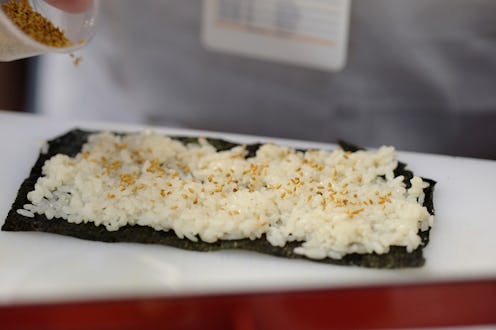Reasons I will never be a professional chef (besides the rather essential fact that I have no desire to be one) include my presentation skills — or rather, my lack thereof. You know who has phenomenal presentation skills, though? Anyone who knows how to make Japanese damukare, or “dam curry rice.” Why is it called “dam curry rice?” Because the rice functions as a dam, of course. It protects anything on your plate that shouldn't be served with curry sauce (although the contrarian in me would argue that there's no such thing) from getting covered in the stuff — and it's also absolutely beautiful. We're talking “too pretty to eat” territory, although I'm sure it's absolutely delicious, too.
According to Bored Panda, damukare dates back to 1965; it's seen something of a renaissance recently, though, with interest in the food art form (because let's face it: That's definitely edible art) kicking up in 2007 and increasing ever since then. Kotaku gets the credit for bringing it to our attention this time round with a post initially published at the beginning of April, although Rocket News also gets a mention for picking it up a few days ago. From there, it was only a short jump to Bored Panda, Imgur, and the rest of the Internet, and, well… welcome to your new favorite food obsession.
I mean, look at these things:
How amazing are they?
So amazing I don't even know what to do with myself.
That's how amazing they are.
I'll admit that I'm curious about what goes into making the rice used for damukare. I would imagine you've got to use a short-grained variety, since those tend to be stickier than the long-grained ones — but what else do you do to it? I was gifted sushi-making supplies for Christmas last year, and of the many, many things I've learned during my subsequent forays into rolling sushi, perhaps the most surprising is all the steps that go into making proper sushi rice. You're probably already aware that rinsing your rice before cooking it will make it that much better — but to make rice suitable for sushi, you've really got to rinse it until the water runs mostly clear. Then you cook it; then you have to turn it out and fan it in an extremely particular method until it's cool enough to handle. Then you have to dress it with rice vinegar and a few other things, and then — and only then — is it ripe for sushi-making. So: Does all that go into making the kind of rice you use to make these cute little dams? Is there a whole 'nother process for it? I was unable to find any information written in English about it, but you guys! I need to know! Can anyone enlighten me?
Check out a few more examples in the Imgur album here — and if anyone knows of a restaurant anywhere in the Tri-State Area that makes damukare, please tell me. I'd definitely eat that.
